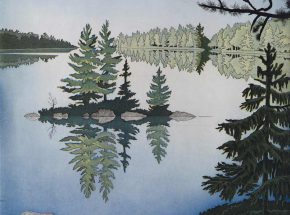

Described as “one of the great mysteries in Minnesota painting”, Magnus Norstad is known primarily for one painting, City on a Hill, a snowscene that won the Silver Medal Award in 1917 for the Third Annual Exhibition of Northwestern Artists at the St. Paul Institute. The work is now in the Minnesota Historical Society.
Norstad was born in Bedo, Norway. He later said that as a child he was so interested in painting that he made brushes from his own hair. In 1900, when he was age fifteen, he and his family emigrated to the United States, settling first in Seattle. In 1905, he went to New York City to study at the National Academy of Design, where he won the Charles Loring Elliot Silver Medal for drawing from the antique. Because of the similarity in style and subject matter, it is thought that one of his teachers and influences was Emil Carlsen (1853-1932), a Danish immigrant and Academy teacher when Norstad was a student.
By 1911, Norstad was listed in the City Directory in St. Paul, Minnesota, and was working for Pioneer Company as an illustrator. Then from 1916 to 1918, he did free-lance work. He was married to Lillian Rosland, a Swedish-American girl from Red Wing, Minnesota who had been an art student in St. Paul. In 1914, the couple painted in Glacier National Park, with Norstad doing promotional paintings for Louis W. Hill, owner of the Great Northern Railroad.
Norstad was active in the Twin Cities art world. In 1913, he was elected to the Attic Club of Minneapolis, an entry that led leaders of that organization to abandon their requirement that members live only in that city. He exhibited paintings in the first four annual exhibitions of Works by Northwestern Artists at the St. Paul Institute, 1915-1918, and at the State Art Society in 1913-1914 and 1916-1917.
On November 4, 1917, Norstad wrote a letter to Louis W. Hill saying that if he had “only $2000 he would perpetuate the city of St. Paul with canvas and paint and make a showing down East. . . Well Mr. Hill, I’m sure going to get there and make good sooner or later.”
Apparently Hill did not respond to the hint for money. In 1919, Magnus Norstad moved to New York and settled in Valhalla, where he designed and built his own home with a stone exterior. Commuting by train to New York City, he worked as a freelance commercial artist. Poster designing was one of his specialties, and he also did magazine illustrations for Redbook. In the summer of 1921, he studied for two months at the Art Students League. During this time, he did very little easel painting, but he he exhibited paintings with the Society of Scandinavian Artists at the Brooklyn Museum in February 1926, and the previous year entered two paintings in the Norse-American Centennial Exhibition in St. Paul.
Shortly after World War II, Norstad moved to southern California. Either unwilling or unable to move or find storage for his art work, he burned many of his canvases. His family has located only about twelve paintings by him.
In California, he devoted much more time to building houses than to fine-art painting. Norstad died in Oak Glen in 1962. Of him it was said: “Easel painting had been Norstad’s love and commercial art his living.”
Sources include:
Marion John Nelson, Painting by Minnesotans of Norwegian Background
1870-1970, Norwegian-American Historical Association.
Submitted November 2005 by Karen Norstad Vickers, grand daughter of the artist.
